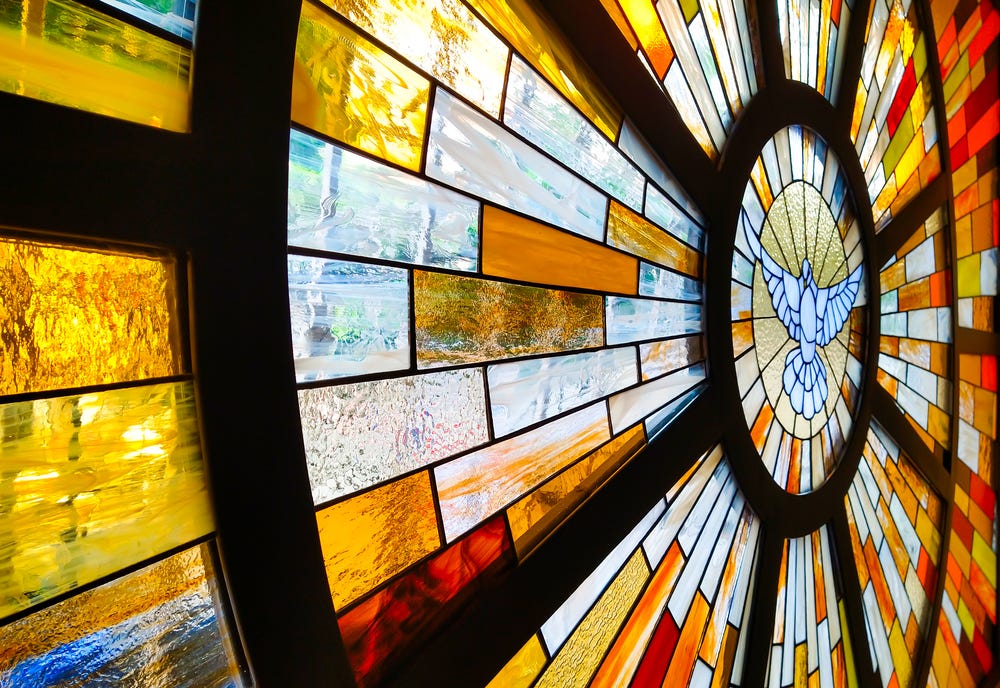A Historical Look at Stained Glass

Glass has been around for thousands of years and was used in many ancient cultures, from Egypt to Ancient Rome. Those cultures made small items with color in them, like cups and vases. We'll never know for sure who first invented stained glass windows, but the early techniques used may have been inspired by the making of mosaics and jewelry. The use of stained glass windows became more widely used between the 7th and 10th centuries, during which time it could be found in British monasteries and then later in Germany and France. The earliest known example was from 675 AD whereby Benedict Biscop commissioned workers from France to make stained glass for a monastery at Saint Peter in England.
The popularity of stained glass peaked during the Middle Ages and, instead of using geometric designs, stained glass makers began creating more intricate pieces. These windows made it possible to illustrate stories from the Bible and the lives of saints. However, designers didn't focus as much on realism; they focused instead on illustration and ideas. As a result, people who couldn't read the Bible were able to better understand its meaning with this art form.
Throughout the centuries, stained glass changed, moving from the Gothic style to the Classical. The new Classical style made use of more translucent colors. It was thought to be a more skillful style and was favored for over 300 years.
-
The History of the World's Oldest Antique Stained-Glass Windows
-
A Brief History of Stylistic Development in English-Stained Glass
Around the 15th century, stained glass windows were popular ways to decorate public buildings and wealthy homes. Details of figures on plain backgrounds were often painted. During the 18th century, many medieval stained glass panes of glass were removed from windows during remodeling projects and replaced with painted glass.
The mid-1800s revival of Catholicism in England led to the building of many new churches and cathedrals, as well as many restored old ones. This resulted in a renewed interest in the Gothic style. As a result, stained glass manufacturers started producing windows with this medieval design. This is the type of window we continue to associate with stained glass today.
In the late 19th century, English-born immigrant artists, such as William Jay Bolton and Joseph & Richard Lamb, grabbed the spotlight. These gentlemen established stained glass studios that were initially producing Gothic-style ecclesiastical vases. However, this was before Americans established their own style of stained-glass windows. John La Farge and Louis Comfort Tiffany soon became two of the leading painters in this new revolution. They created an opalescent glass that used no paint to produce various effects. As competitors, both performed patents for these windows. Besides being a tough opponent for Tiffany's popularity, The Tiffany style still maintained a huge percentage of its popularity through the turn of the 20th century.
After the Great War, the Gothic style was popular for windows in Neo-Gothic churches. On the other hand, opalescent stained glass fell out of favor after the death of John La Farge in 1910 and then Louis Tiffany in 1933. The result was an emergence of new artists who had stained glass made for American churches. Throughout all this time, stained glass started to lose popularity until after WWII. It was around that time that abstract expressionists started exploring expression through stained glass, influencing other artists to explore expression as well.
Stained glass has been evolving and growing for the past hundred years. In this new golden age in glass, stained glass is being driven by technological advances and people who want to learn it as a hobby. We typically find stained pieces in doorways, windows, lampshades, or even in our homes as decorative pieces. Newer artists are also creating new styles that create unique designs every day.
Additional Reading on the History of Stained Glass
-
A Guide to Neo-Gothic Architecture: What Is It and How Does It Differ from Traditional Gothic Architecture?
-
Stained Glass: The History, the Art and the Science behind Stained Glasses from ancient times to date.
-
A Brief on the Origin of Stained Glasses: This Is Why Churches Have Stained Glass Windows.
-
Stained Glass Window Resource & History Guide: Stained Glass has an interesting history that is worth knowing.
-
Stained Glass Art: Stained glasses have been used as pieces of art from ancient times.
-
How Were Stained Glass Windows Made? A brief on how stained-glass window is made.
-
How Stained Glass Is Made: The six basic steps in the production of stained glass.
-
Church-Stained Glass Windows: Churches are an example of constructions that used stained glass in ancient times.
-
The Basics of Stained Glasses: You need to know the basics and fundamentals of stained glasses.
-
14 Interesting Facts About Stained Glass Windows: These are some of the interesting facts about stained glass windows.
Stained Glass in Historic Churches and Buildings
-
Exploring Tradition and Ancient Religion: Why Do Churches Have Stained Glass Windows?
-
Historic Church Transformed into a Modern Center for the Arts: Some historic churches transformed into centers of art.
-
Why Stained-Glass Windows Are Omnipresent in Churches: A brief on stained glass windows in churches.
-
Treasure Hunt: Searching for the Works of the Church Glass and Decorating Company of New York.
-
Exploring the History and Purpose of Church-Stained Glass: The uses of Stained Glasses in ancient worship areas.
-
Restoring Historical Stained Glass: Some of the steps you can take when restoring historical stained glasses.
-
What about Stained Historical Glasses: A brief on the emergence and applications of stained glasses.
-
Stained Glass: A look into the technology and the future of stained glasses.
-
Stained Glass Window History and Symbolism: More information on the history and symbolism associated with stained glass.
-
Relocating Historic Church-Stained Glass: More information on the sacred window rescue project.
Stained Glass Art Projects
-
10 Beautiful Stained-Glass Art Projects for Kids: Good projects involving stained glass art for kids.
-
Stained Glass Art for Kids: Encourage creativity among kids with these glass-stained arts.
-
Art and Craft Projects for Kids: Children can engage in some of the glass art projects.
-
Beginner's Guide to Stained Glass: This guide that children can utilize in projects involving stained glass.
-
Mosaics & Glass Art Projects: A guide into arts involving mosaics and glass art projects.
-
Benefits of the Art of Stained Glass: Glass-stained art have been associated with wellness benefits.
-
How to Make Stained Glass at Home: Fundamentals of home-made stained glasses arts.
-
The Tools You Need to Make Stained Glass Art: Important tools that are essential for stained glass art.
-
Stained Glass Quilt Art Project for Kids: What are some of the basics you need to be aware of in stained glass arts?









